Attached files
| file | filename |
|---|---|
| 8-K - 8-K - Aravive, Inc. | arav-8k_20201008.htm |
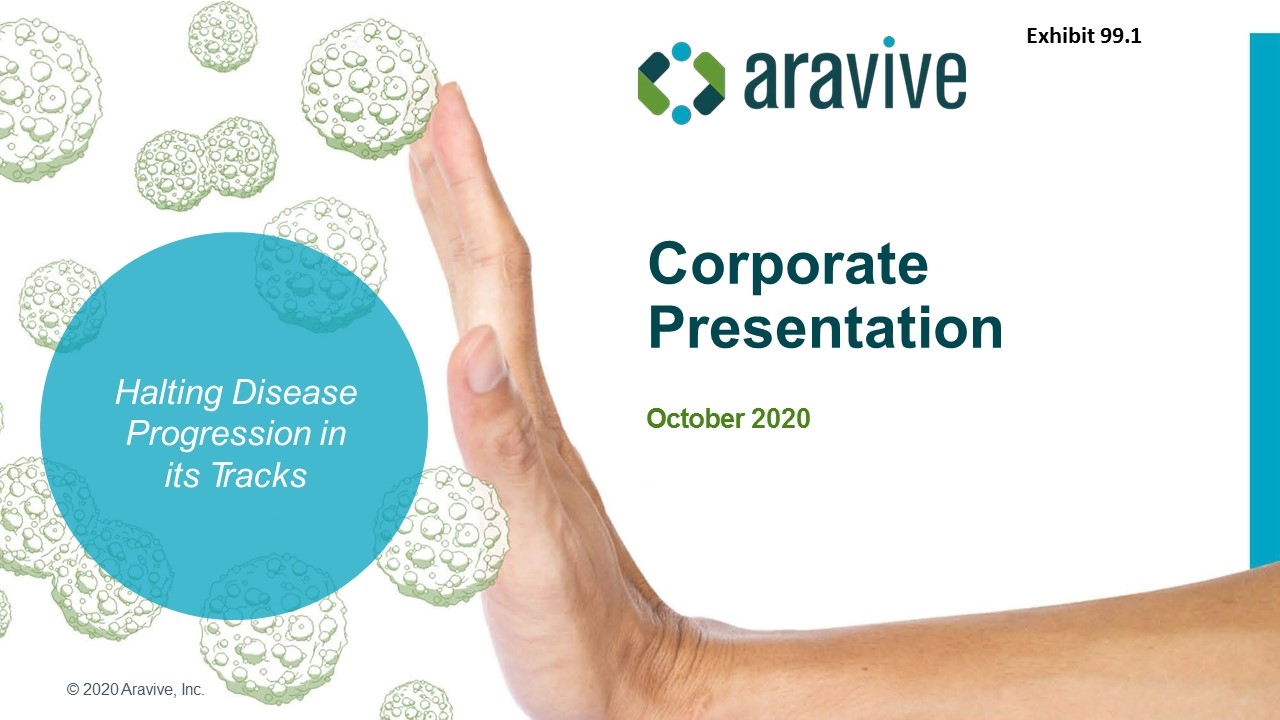
© 2020 Aravive, Inc. Corporate Presentation October 2020 Halting Disease Progression in its Tracks Exhibit 99.1
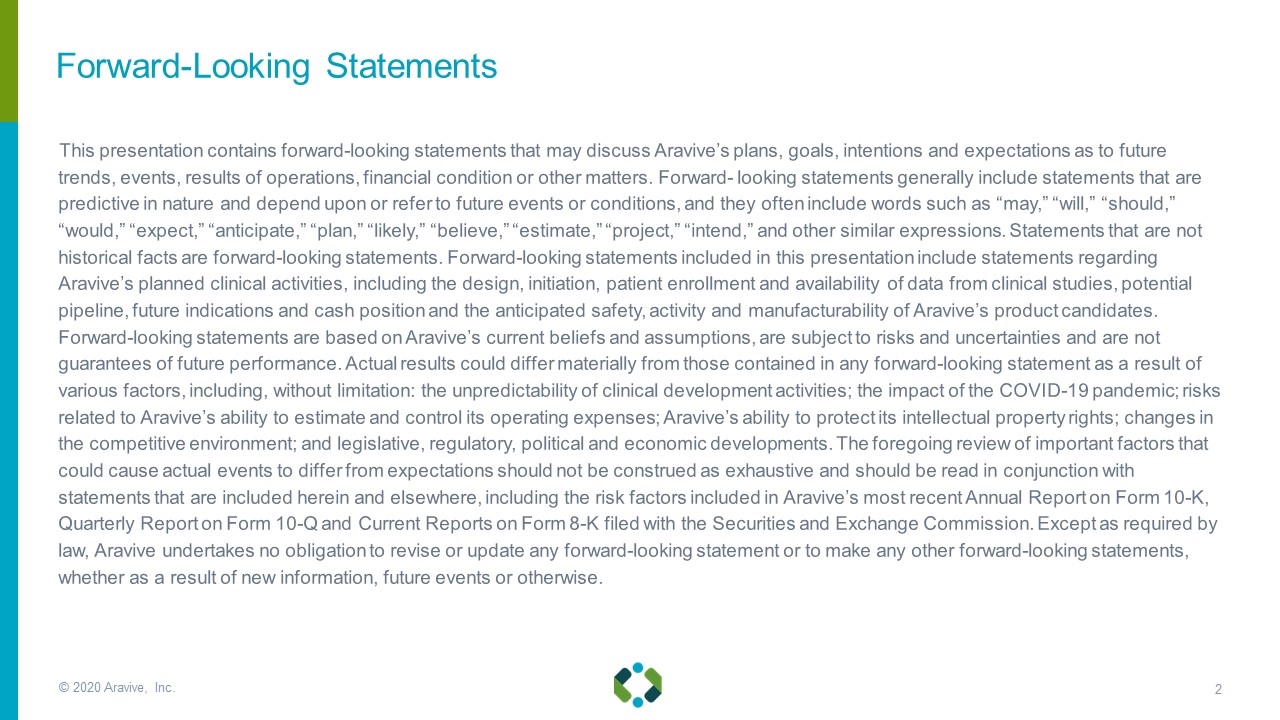
© 2020 Aravive, Inc. Forward-Looking Statements This presentation contains forward-looking statements that may discuss Aravive’s plans, goals, intentions and expectations as to future trends, events, results of operations, financial condition or other matters. Forward- looking statements generally include statements that are predictive in nature and depend upon or refer to future events or conditions, and they often include words such as “may,” “will,” “should,” “would,” “expect,” “anticipate,” “plan,” “likely,” “believe,” “estimate,” “project,” “intend,” and other similar expressions. Statements that are not historical facts are forward-looking statements. Forward-looking statements included in this presentation include statements regarding Aravive’s planned clinical activities, including the design, initiation, patient enrollment and availability of data from clinical studies, potential pipeline, future indications and cash position and the anticipated safety, activity and manufacturability of Aravive’s product candidates. Forward-looking statements are based on Aravive’s current beliefs and assumptions, are subject to risks and uncertainties and are not guarantees of future performance. Actual results could differ materially from those contained in any forward-looking statement as a result of various factors, including, without limitation: the unpredictability of clinical development activities; the impact of the COVID-19 pandemic; risks related to Aravive’s ability to estimate and control its operating expenses; Aravive’s ability to protect its intellectual property rights; changes in the competitive environment; and legislative, regulatory, political and economic developments. The foregoing review of important factors that could cause actual events to differ from expectations should not be construed as exhaustive and should be read in conjunction with statements that are included herein and elsewhere, including the risk factors included in Aravive’s most recent Annual Report on Form 10-K, Quarterly Report on Form 10-Q and Current Reports on Form 8-K filed with the Securities and Exchange Commission. Except as required by law, Aravive undertakes no obligation to revise or update any forward-looking statement or to make any other forward-looking statements, whether as a result of new information, future events or otherwise.
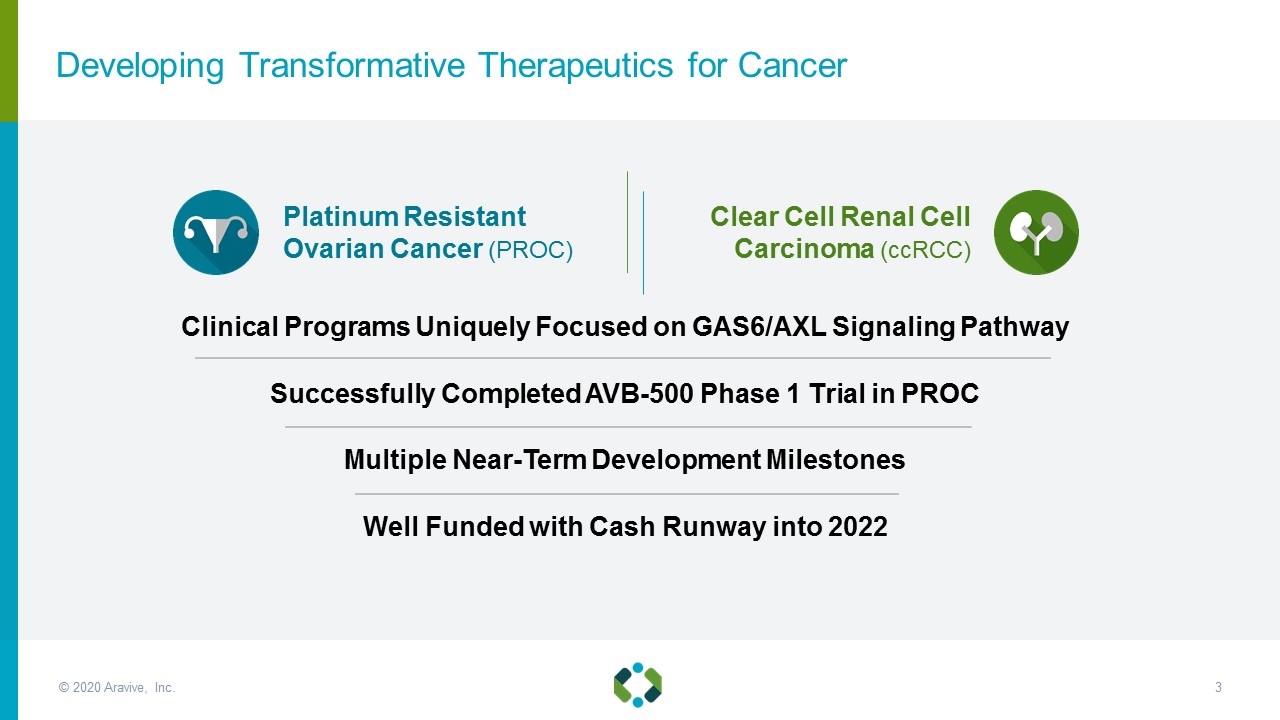
© 2020 Aravive, Inc. Developing Transformative Therapeutics for Cancer Clear Cell Renal Cell Carcinoma (ccRCC) Platinum Resistant Ovarian Cancer (PROC) Clinical Programs Uniquely Focused on GAS6/AXL Signaling Pathway Successfully Completed AVB-500 Phase 1 Trial in PROC Multiple Near-Term Development Milestones Well Funded with Cash Runway into 2022

© 2020 Aravive, Inc. Urgent Needs in Ovarian and Renal Cancer Ovarian Cancer 5th LEADING CAUSE OF DEATH among women in the U.S. ~70% OF PATIENTS are diagnosed with advanced disease 50% 5-YEAR relative survival LESS THAN Renal Cancer 15% 5-YEAR relative survival for metastatic renal cancer 70k NEW CASES expected in the U.S. in 2020 RESISTANCE TO CHEMOTHERAPY is common OVER LESS THAN
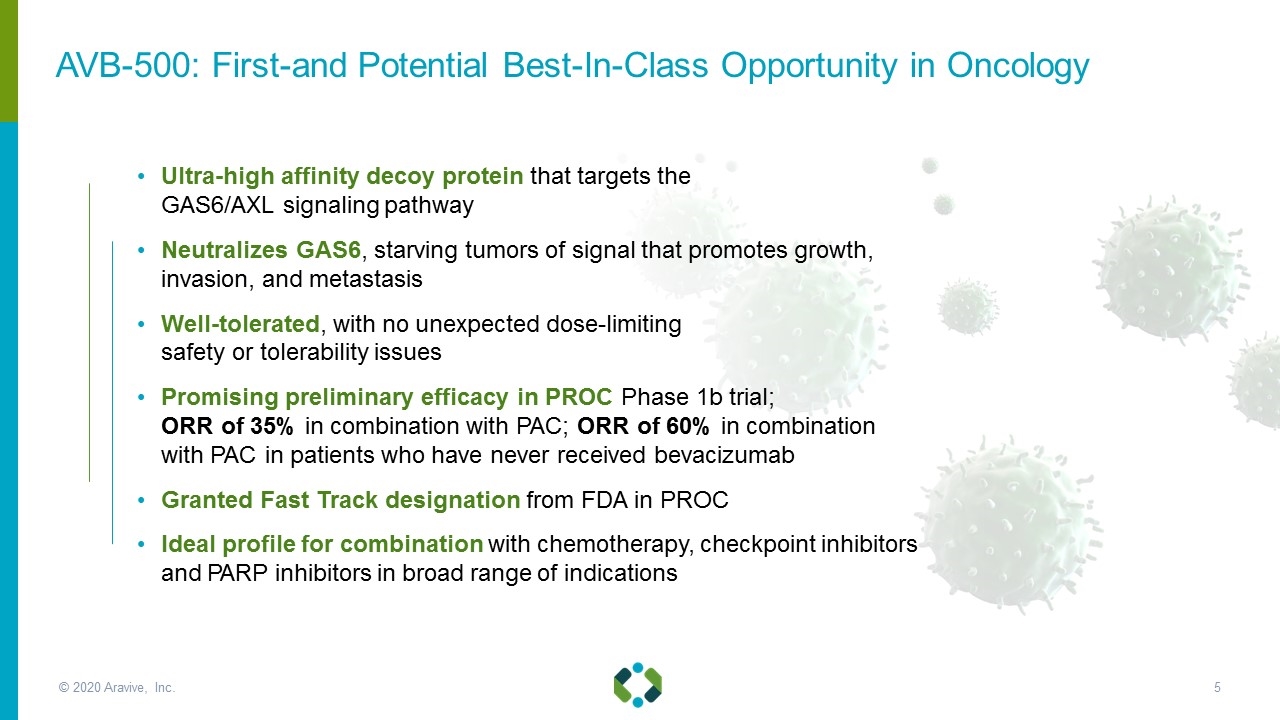
© 2020 Aravive, Inc. AVB-500: First-and Potential Best-In-Class Opportunity in Oncology Ultra-high affinity decoy protein that targets the GAS6/AXL signaling pathway Neutralizes GAS6, starving tumors of signal that promotes growth, invasion, and metastasis Well-tolerated, with no unexpected dose-limiting safety or tolerability issues Promising preliminary efficacy in PROC Phase 1b trial; ORR of 35% in combination with PAC; ORR of 60% in combination with PAC in patients who have never received bevacizumab Granted Fast Track designation from FDA in PROC Ideal profile for combination with chemotherapy, checkpoint inhibitors and PARP inhibitors in broad range of indications
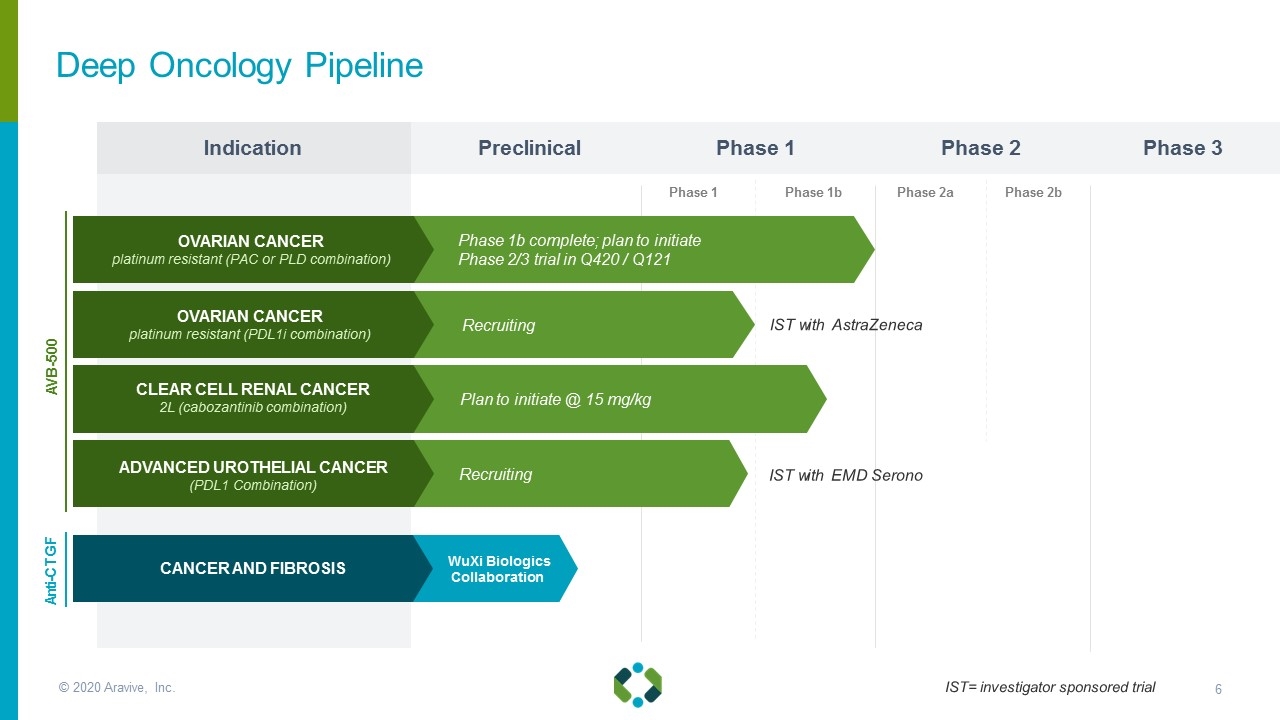
© 2020 Aravive, Inc. Indication Preclinical 3rd Oncology Phase 1 Phase 3 Phase 2 Phase 2a Phase 2b Anti-CTGF AVB-500 IST with AstraZeneca Phase 1b complete; plan to initiate Phase 2/3 trial in Q420 / Q121 OVARIAN CANCER platinum resistant (PAC or PLD combination) Recruiting OVARIAN CANCER platinum resistant (PDL1i combination) Plan to initiate @ 15 mg/kg CLEAR CELL RENAL CANCER 2L (cabozantinib combination) Recruiting ADVANCED UROTHELIAL CANCER (PDL1 Combination) IST with EMD Serono IST= investigator sponsored trial Deep Oncology Pipeline Phase 1 Phase 1b WuXi Biologics Collaboration CANCER AND FIBROSIS
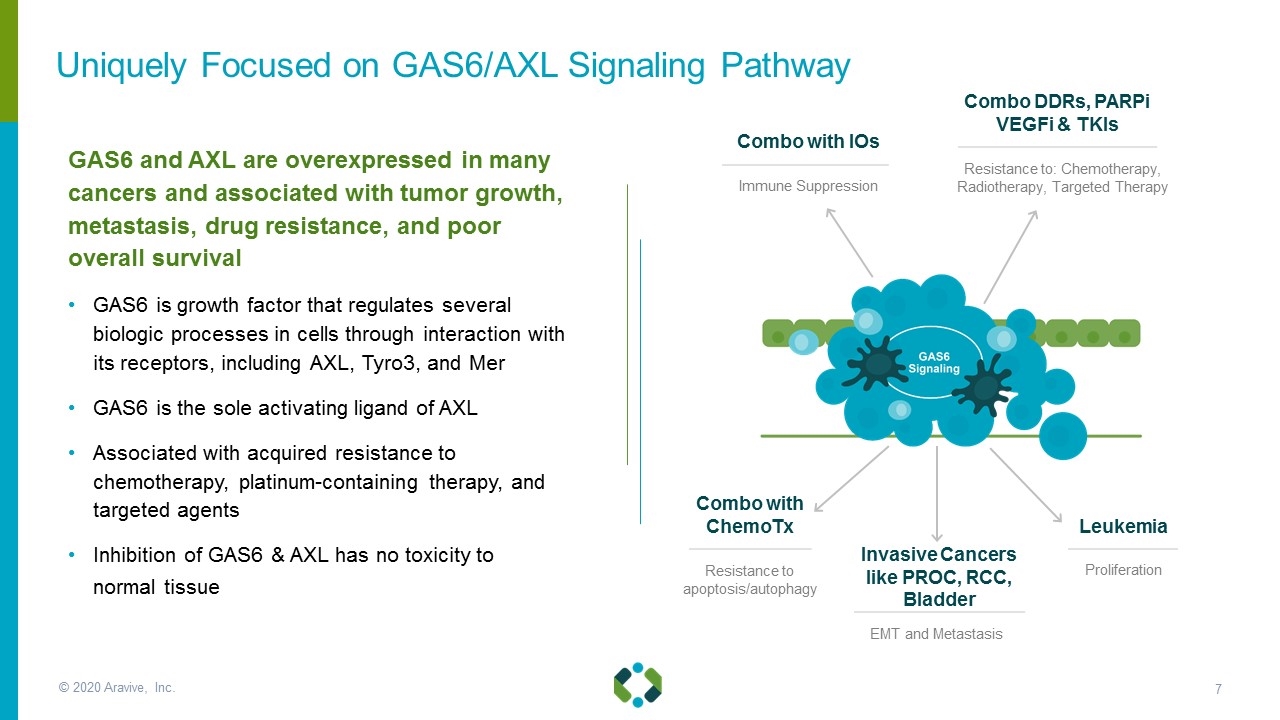
GAS6 and AXL are overexpressed in many cancers and associated with tumor growth, metastasis, drug resistance, and poor overall survival GAS6 is growth factor that regulates several biologic processes in cells through interaction with its receptors, including AXL, Tyro3, and Mer GAS6 is the sole activating ligand of AXL Associated with acquired resistance to chemotherapy, platinum-containing therapy, and targeted agents Inhibition of GAS6 & AXL has no toxicity to normal tissue Uniquely Focused on GAS6/AXL Signaling Pathway © 2020 Aravive, Inc. Combo DDRs, PARPi VEGFi & TKIs Resistance to: Chemotherapy, Radiotherapy, Targeted Therapy Combo with IOs Immune Suppression Combo with ChemoTx Resistance to apoptosis/autophagy Invasive Cancers like PROC, RCC, Bladder EMT and Metastasis Leukemia Proliferation
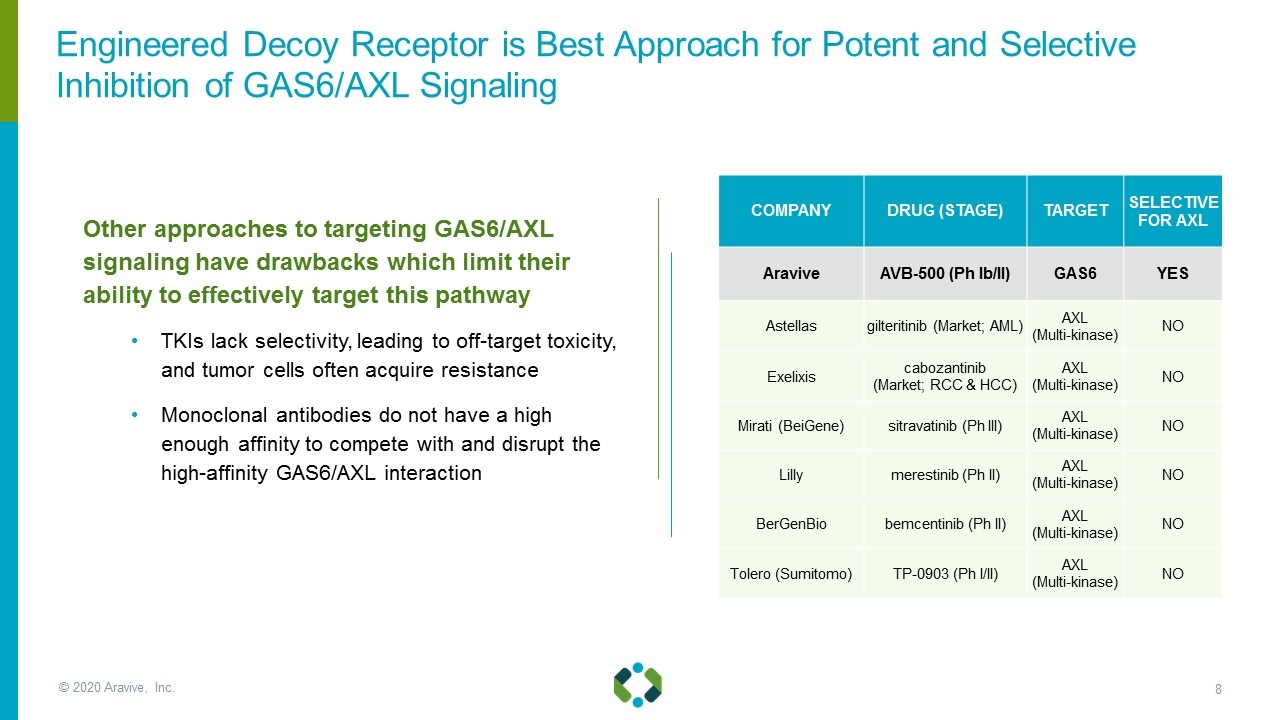
© 2020 Aravive, Inc. COMPANY DRUG (STAGE) TARGET SELECTIVE FOR AXL Aravive AVB-500 (Ph Ib/II) GAS6 YES Astellas gilteritinib (Market; AML) AXL (Multi-kinase) NO Exelixis cabozantinib (Market; RCC & HCC) AXL (Multi-kinase) NO Mirati (BeiGene) sitravatinib (Ph III) AXL (Multi-kinase) NO Lilly merestinib (Ph II) AXL (Multi-kinase) NO BerGenBio bemcentinib (Ph II) AXL (Multi-kinase) NO Tolero (Sumitomo) TP-0903 (Ph I/II) AXL (Multi-kinase) NO Engineered Decoy Receptor is Best Approach for Potent and Selective Inhibition of GAS6/AXL Signaling Other approaches to targeting GAS6/AXL signaling have drawbacks which limit their ability to effectively target this pathway TKIs lack selectivity, leading to off-target toxicity, and tumor cells often acquire resistance Monoclonal antibodies do not have a high enough affinity to compete with and disrupt the high-affinity GAS6/AXL interaction

© 2020 Aravive, Inc. AVB-500 (AVB): q14 days Pegylated liposomal doxorubicin (PLD) 40 mg/m2 d1, or 28-day cycle paclitaxel (PAC): 80 mg/m2 day 1, day 8, day 15; Maintenance dosing on AVB-500 monotherapy AVB 500 10 mg/kg + PLD (N=21) AVB 500 15 mg/kg + PLD (N=2) Select RP2D AVB 500 10 mg/kg + PAC (N=16) AVB 500 15 mg/kg + PAC (N=3) PLATINUM-RESISTANT OVARIAN CANCER AVB 500 20 mg/kg + PLD (N=3) AVB 500 20 mg/kg + PAC (N=4) Key Eligibility Criteria 1-3 prior lines of therapy, not including maintenance or adjuvant therapy Measurable disease Platinum free interval ≤ 6mo after most recent platinum-containing regimen Adults with adenocarcinoma NOS, high grade endometrioid adenocarcinoma, mixed epithelial (≥ 80% high grade serous), high grade serous, or undifferentiated carcinoma ECOG performance status 0-1 iDMC= Independent Data Monitoring Committee NOS= Not Otherwise Specified ECOG= Eastern Cooperative Oncology Group iDMC Review iDMC Review Successfully Completed AVB-500 Phase 1b Trial in PROC
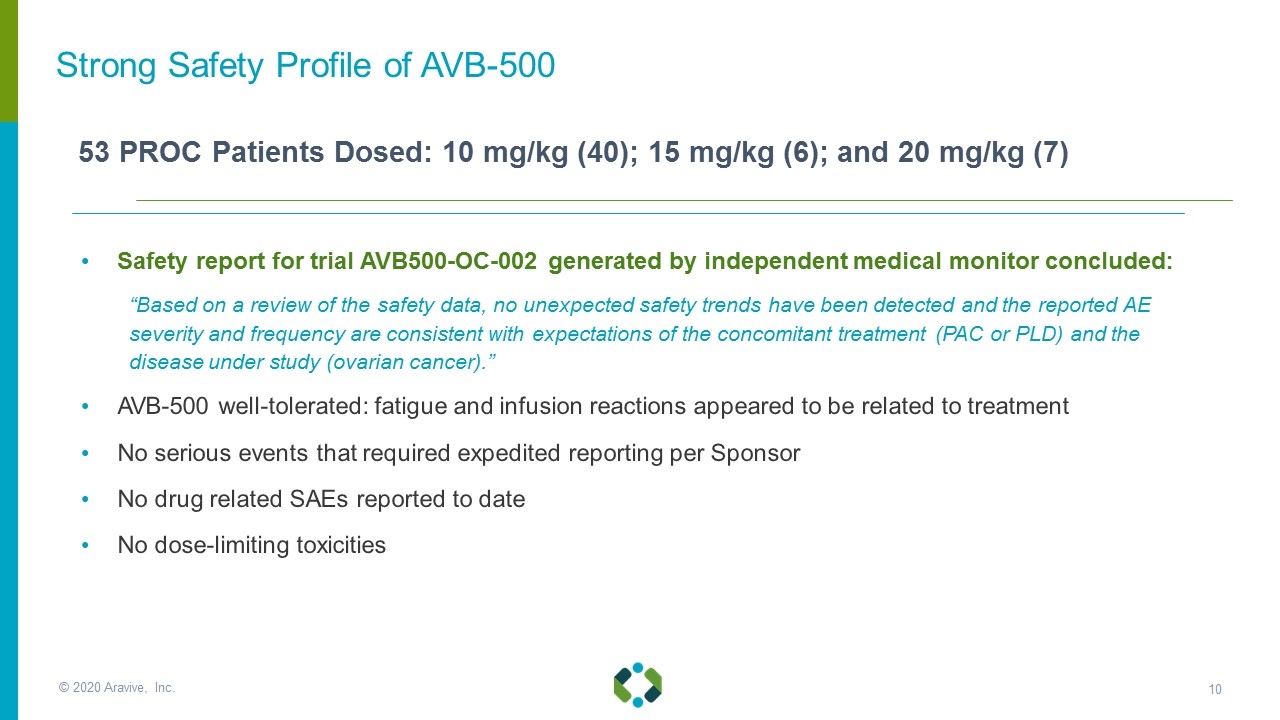
Safety report for trial AVB500-OC-002 generated by independent medical monitor concluded: “Based on a review of the safety data, no unexpected safety trends have been detected and the reported AE severity and frequency are consistent with expectations of the concomitant treatment (PAC or PLD) and the disease under study (ovarian cancer).” AVB-500 well-tolerated: fatigue and infusion reactions appeared to be related to treatment No serious events that required expedited reporting per Sponsor No drug related SAEs reported to date No dose-limiting toxicities 53 PROC Patients Dosed: 10 mg/kg (40); 15 mg/kg (6); and 20 mg/kg (7) Strong Safety Profile of AVB-500 © 2020 Aravive, Inc.
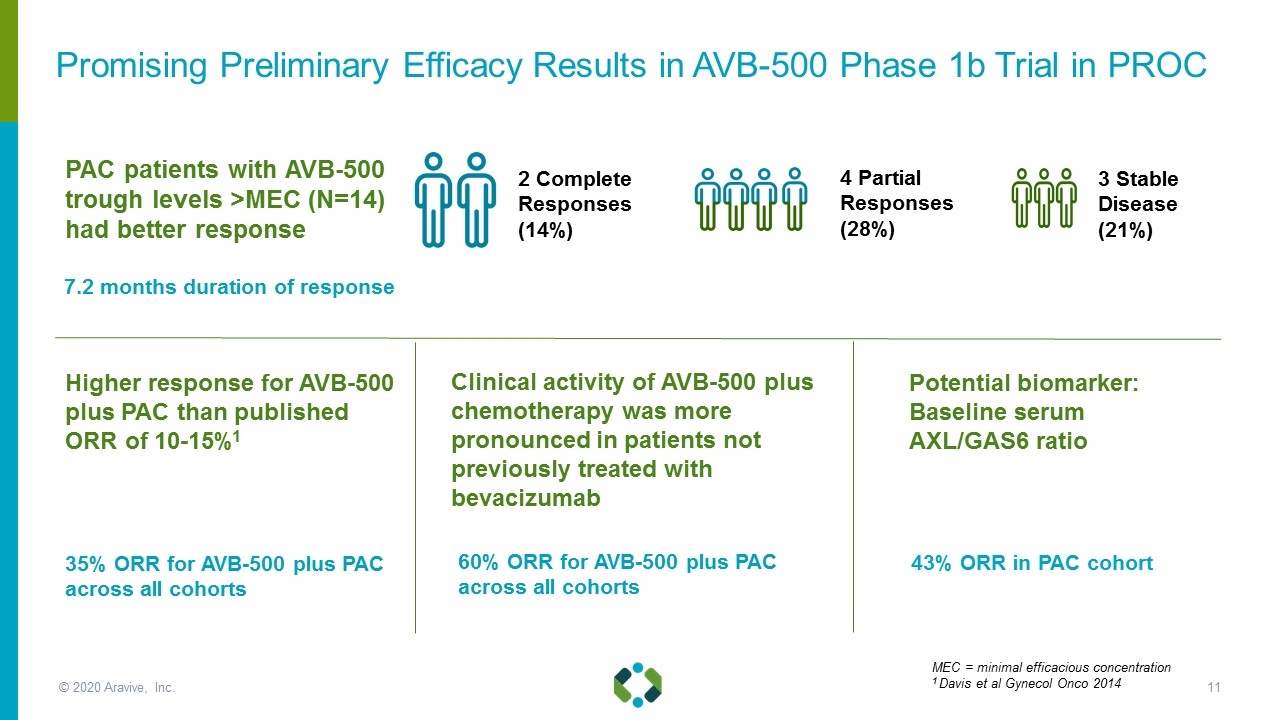
© 2020 Aravive, Inc. Promising Preliminary Efficacy Results in AVB-500 Phase 1b Trial in PROC PAC patients with AVB-500 trough levels >MEC (N=14) had better response Higher response for AVB-500 plus PAC than published ORR of 10-15%1 Clinical activity of AVB-500 plus chemotherapy was more pronounced in patients not previously treated with bevacizumab Potential biomarker: Baseline serum AXL/GAS6 ratio 2 Complete Responses (14%) 3 Stable Disease (21%) 4 Partial Responses (28%) 35% ORR for AVB-500 plus PAC across all cohorts 60% ORR for AVB-500 plus PAC across all cohorts 43% ORR in PAC cohort MEC = minimal efficacious concentration 1 Davis et al Gynecol Onco 2014 7.2 months duration of response
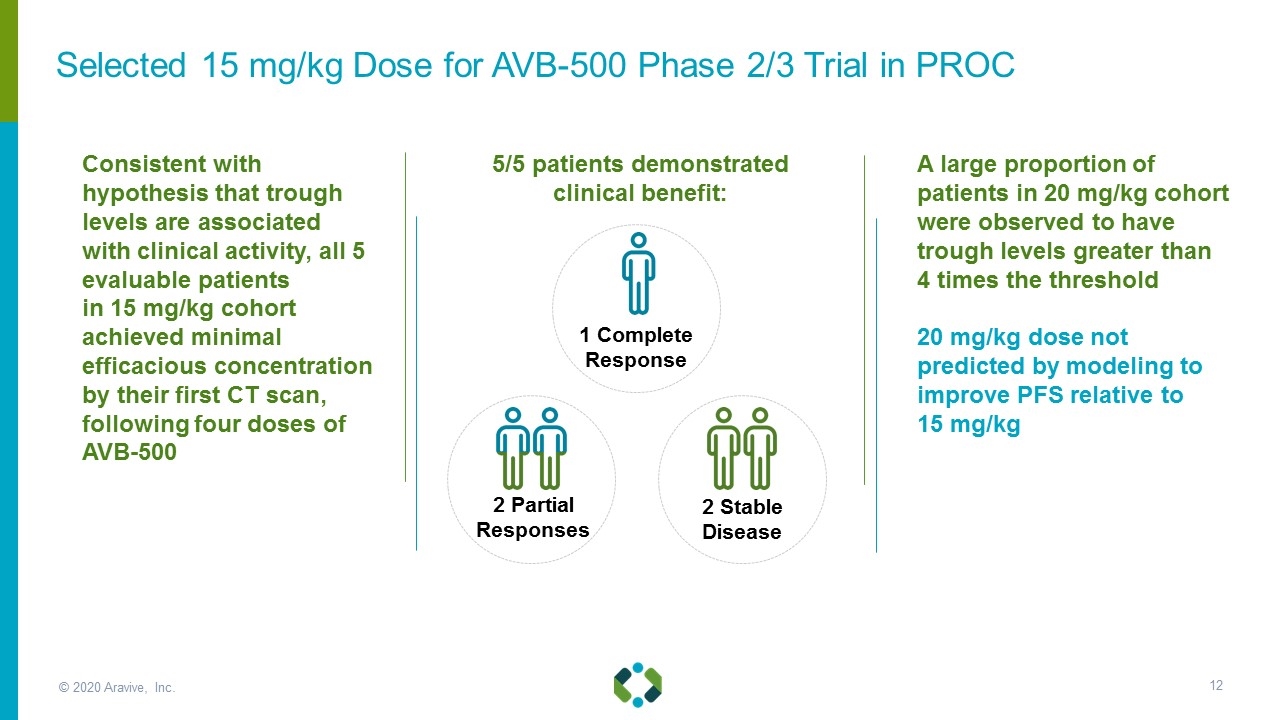
Selected 15 mg/kg Dose for AVB-500 Phase 2/3 Trial in PROC © 2020 Aravive, Inc. Consistent with hypothesis that trough levels are associated with clinical activity, all 5 evaluable patients in 15 mg/kg cohort achieved minimal efficacious concentration by their first CT scan, following four doses of AVB-500 1 Complete Response 2 Stable Disease 2 Partial Responses 5/5 patients demonstrated clinical benefit: A large proportion of patients in 20 mg/kg cohort were observed to have trough levels greater than 4 times the threshold 20 mg/kg dose not predicted by modeling to improve PFS relative to 15 mg/kg

INVESTIGATOR-ASSESSED BEST RESPONSE PER RECIST V1.1 PAC (N=23) PLD (N=26) CR 2 (8.7%) 0 PR 6 (26%) 4 (15%) ORR 8 (35%) 4 (15%) SD 6 (26%) 12 (46%) CBR 14 (61%) 16 (61.5%) PD 9 (39%) 10 (38.5%) 24% ORR across all dose cohorts (12/49 patients) 1 A. Davis et al. / Gynecologic Oncology 133 (2014) 624–631 Response Higher with AVB-500 + PAC than Historical Data of 10-15%1 Summary of all Cohorts, Evaluable Per Protocol © 2020 Aravive, Inc.
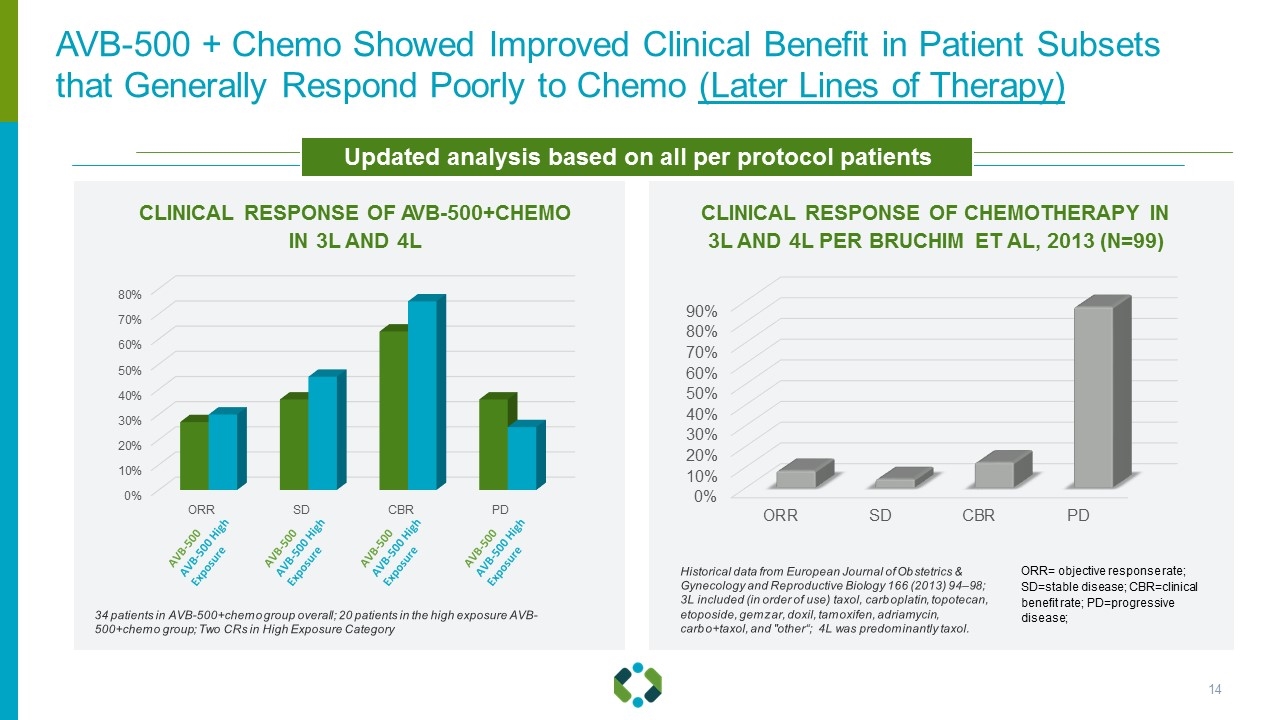
CLINICAL RESPONSE OF AVB-500+CHEMO IN 3L AND 4L CLINICAL RESPONSE OF CHEMOTHERAPY IN 3L AND 4L PER BRUCHIM ET AL, 2013 (N=99) 34 patients in AVB-500+chemo group overall; 20 patients in the high exposure AVB-500+chemo group; Two CRs in High Exposure Category Updated analysis based on all per protocol patients ORR= objective response rate; SD=stable disease; CBR=clinical benefit rate; PD=progressive disease; Historical data from European Journal of Obstetrics & Gynecology and Reproductive Biology 166 (2013) 94–98; 3L included (in order of use) taxol, carboplatin, topotecan, etoposide, gemzar, doxil, tamoxifen, adriamycin, carbo+taxol, and "other“; 4L was predominantly taxol. AVB-500 + Chemo Showed Improved Clinical Benefit in Patient Subsets that Generally Respond Poorly to Chemo (Later Lines of Therapy)

CLINICAL RESPONSE OF CHEMOTHERAPY IN PATIENTS WITH <3MO PFI PER KOBAYASHI-KATO ET AL, 2019 (N=21) CLINICAL RESPONSE OF AVB-500+CHEMO IN PATIENTS WITH <3MO PFI ORR= objective response rate; SD=stable disease; CBR=clinical benefit rate; PD=progressive disease; PFI=platinum-free interval 16 patients in AVB-500 +chemo group overall, 12 patients in the high exposure AVB-500 +chemo group; Two responders in chemo + AVB-500 high exposure group had CR. Historical data from Cancer Chemotherapy and Pharmacology (2019) 84:33-39 37; included PLD; GEM; CPT-11 (irinotecan); topotecan; and paclitaxel; no CRs in historical data (1 PR in historical data) AVB-500 + Chemo Showed Improved Clinical Benefit in Patient Subsets that Generally Respond Poorly to Chemo (PFI < 3 months) Updated analysis based on all per protocol patients
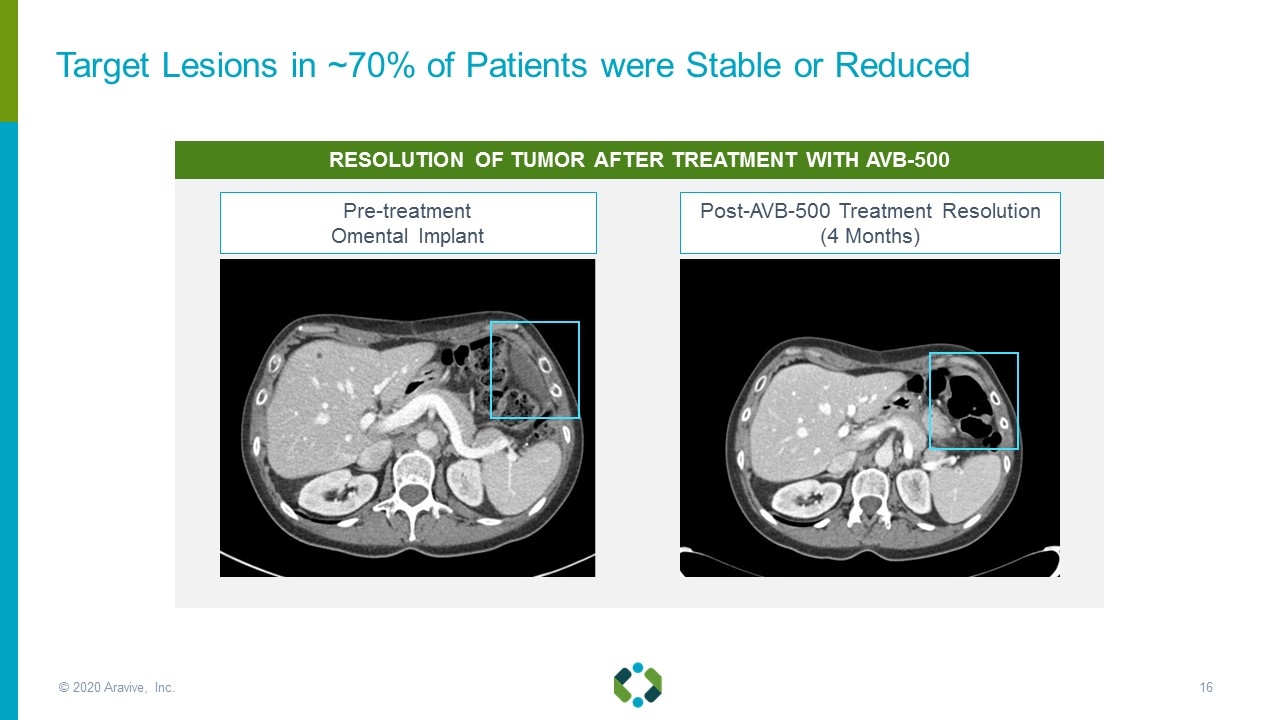
Target Lesions in ~70% of Patients were Stable or Reduced © 2020 Aravive, Inc. RESOLUTION OF TUMOR AFTER TREATMENT WITH AVB-500 Pre-treatment Omental Implant Post-AVB-500 Treatment Resolution (4 Months)
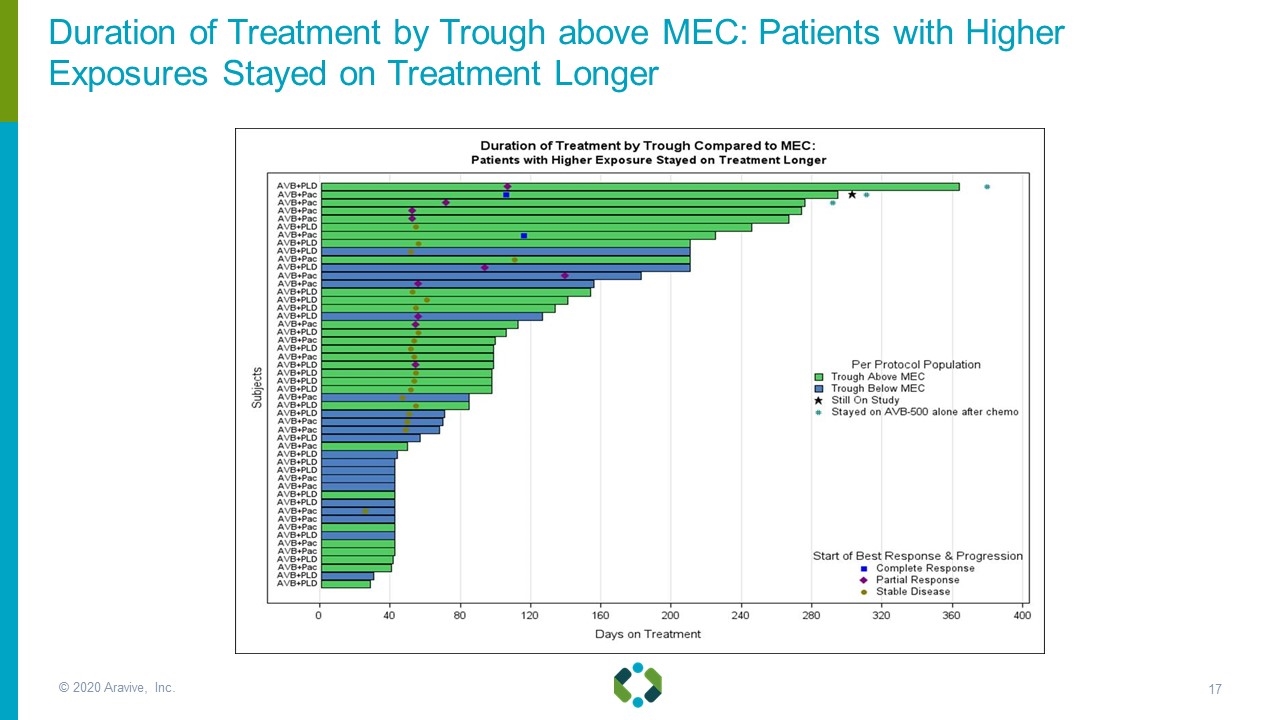
Duration of Treatment by Trough above MEC: Patients with Higher Exposures Stayed on Treatment Longer © 2020 Aravive, Inc.
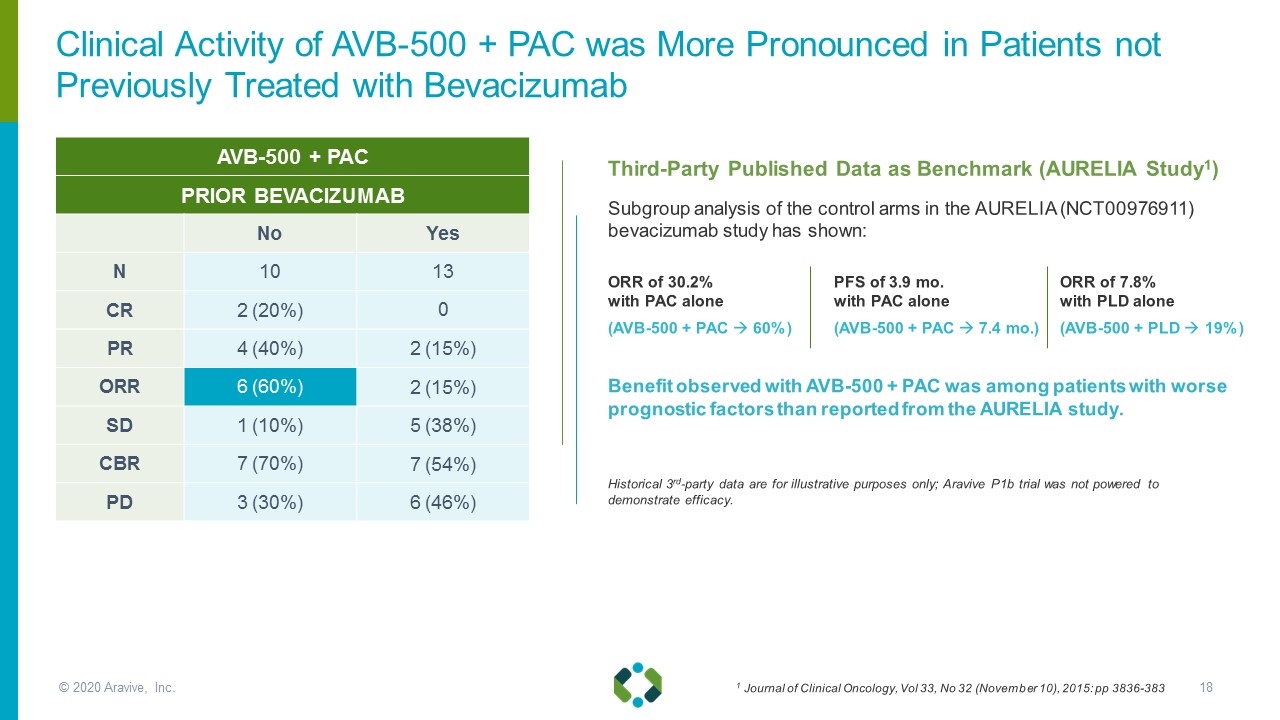
AVB-500 + PAC PRIOR BEVACIZUMAB No Yes N 10 13 CR 2 (20%) 0 PR 4 (40%) 2 (15%) ORR 6 (60%) 2 (15%) SD 1 (10%) 5 (38%) CBR 7 (70%) 7 (54%) PD 3 (30%) 6 (46%) Third-Party Published Data as Benchmark (AURELIA Study1) Subgroup analysis of the control arms in the AURELIA (NCT00976911) bevacizumab study has shown: Clinical Activity of AVB-500 + PAC was More Pronounced in Patients not Previously Treated with Bevacizumab © 2020 Aravive, Inc. Benefit observed with AVB-500 + PAC was among patients with worse prognostic factors than reported from the AURELIA study. Historical 3rd-party data are for illustrative purposes only; Aravive P1b trial was not powered to demonstrate efficacy. ORR of 30.2% with PAC alone (AVB-500 + PAC à 60%) PFS of 3.9 mo. with PAC alone (AVB-500 + PAC à 7.4 mo.) ORR of 7.8% with PLD alone (AVB-500 + PLD à 19%) 1 Journal of Clinical Oncology, Vol 33, No 32 (November 10), 2015: pp 3836-383
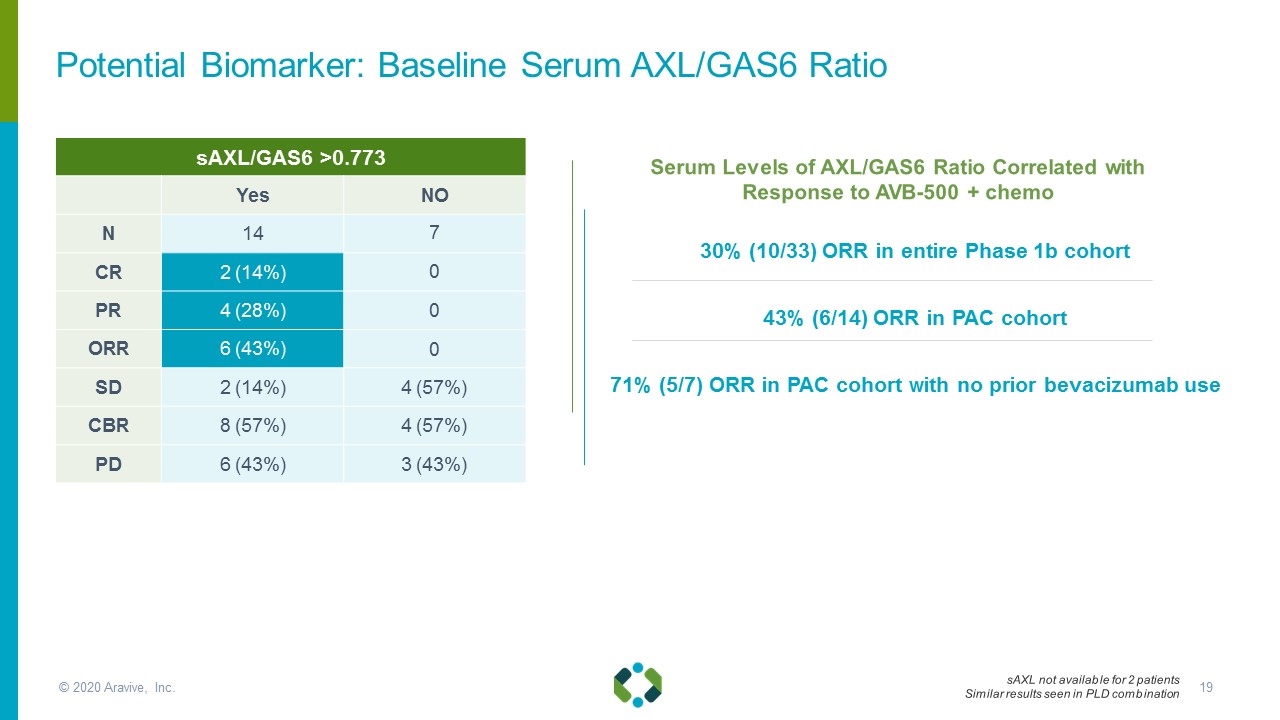
sAXL/GAS6 >0.773 Yes NO N 14 7 CR 2 (14%) 0 PR 4 (28%) 0 ORR 6 (43%) 0 SD 2 (14%) 4 (57%) CBR 8 (57%) 4 (57%) PD 6 (43%) 3 (43%) sAXL not available for 2 patients Similar results seen in PLD combination Serum Levels of AXL/GAS6 Ratio Correlated with Response to AVB-500 + chemo Potential Biomarker: Baseline Serum AXL/GAS6 Ratio © 2020 Aravive, Inc. 30% (10/33) ORR in entire Phase 1b cohort 43% (6/14) ORR in PAC cohort 71% (5/7) ORR in PAC cohort with no prior bevacizumab use
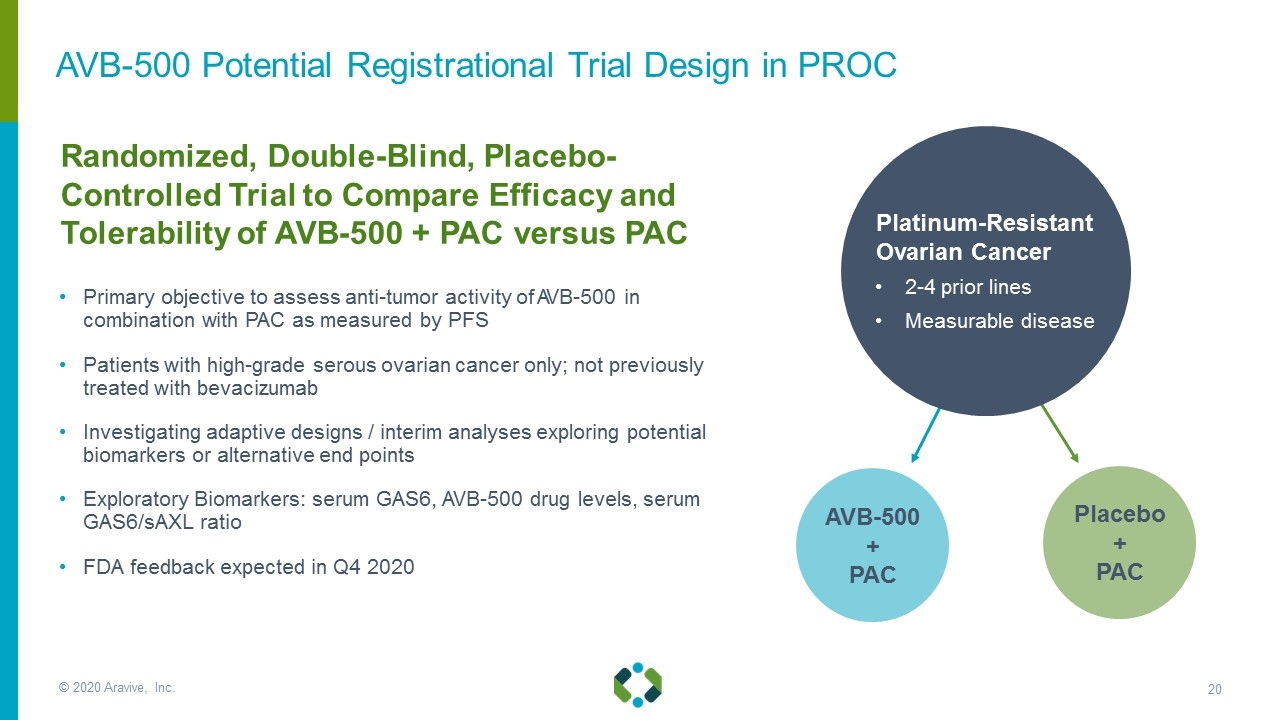
Potential Registrational Study Primary objective to assess anti-tumor activity of AVB-500 in combination with PAC as measured by PFS Patients with high-grade serous ovarian cancer only; not previously treated with bevacizumab Investigating adaptive designs / interim analyses exploring potential biomarkers or alternative end points Exploratory Biomarkers: serum GAS6, AVB-500 drug levels, serum GAS6/sAXL ratio FDA feedback expected in Q4 2020 © 2020 Aravive, Inc. Randomized, Double-Blind, Placebo-Controlled Trial to Compare Efficacy and Tolerability of AVB-500 + PAC versus PAC AVB-500 Potential Registrational Trial Design in PROC AVB-500 + PAC Placebo + PAC Platinum-Resistant Ovarian Cancer 2-4 prior lines Measurable disease
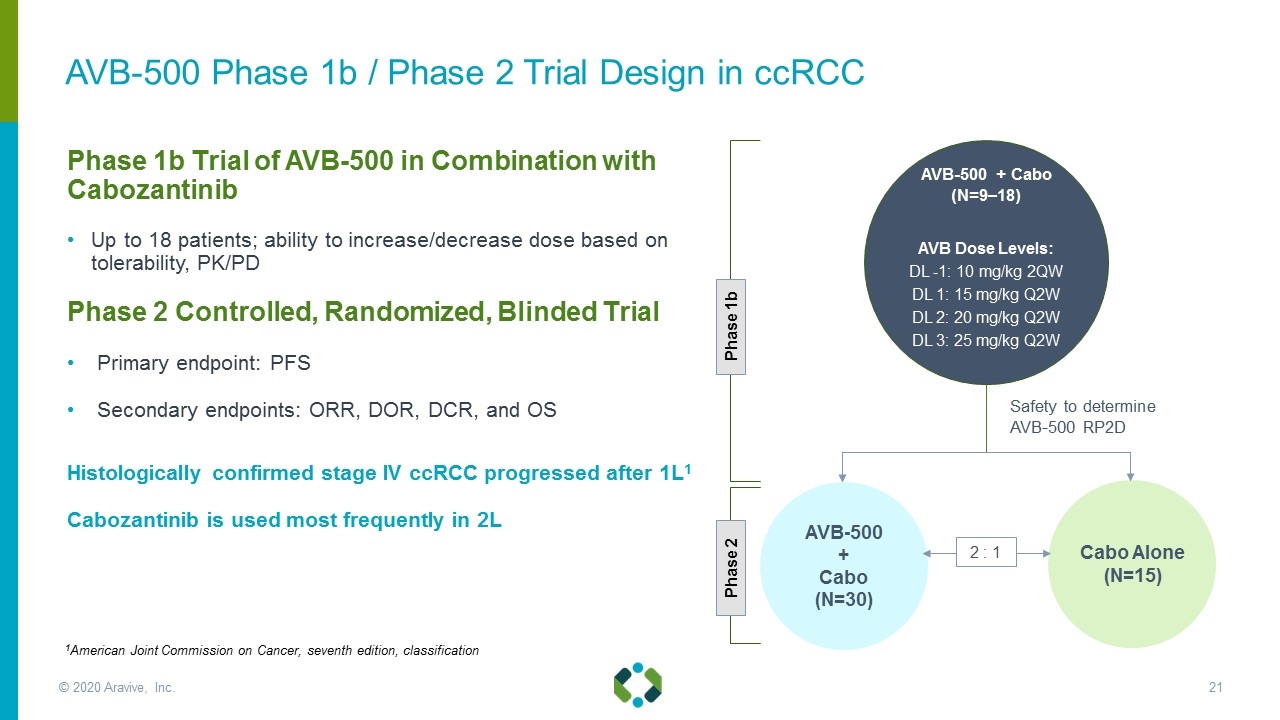
Phase 1b Trial of AVB-500 in Combination with Cabozantinib Up to 18 patients; ability to increase/decrease dose based on tolerability, PK/PD Phase 2 Controlled, Randomized, Blinded Trial Primary endpoint: PFS Secondary endpoints: ORR, DOR, DCR, and OS Histologically confirmed stage IV ccRCC progressed after 1L1 Cabozantinib is used most frequently in 2L AVB-500 Phase 1b / Phase 2 Trial Design in ccRCC AVB-500 + Cabo (N=9–18) AVB Dose Levels: DL -1: 10 mg/kg 2QW DL 1: 15 mg/kg Q2W DL 2: 20 mg/kg Q2W DL 3: 25 mg/kg Q2W AVB-500 + Cabo (N=30) Cabo Alone (N=15) 2 : 1 Safety to determine AVB-500 RP2D Phase 1b Phase 2 1American Joint Commission on Cancer, seventh edition, classification © 2020 Aravive, Inc.
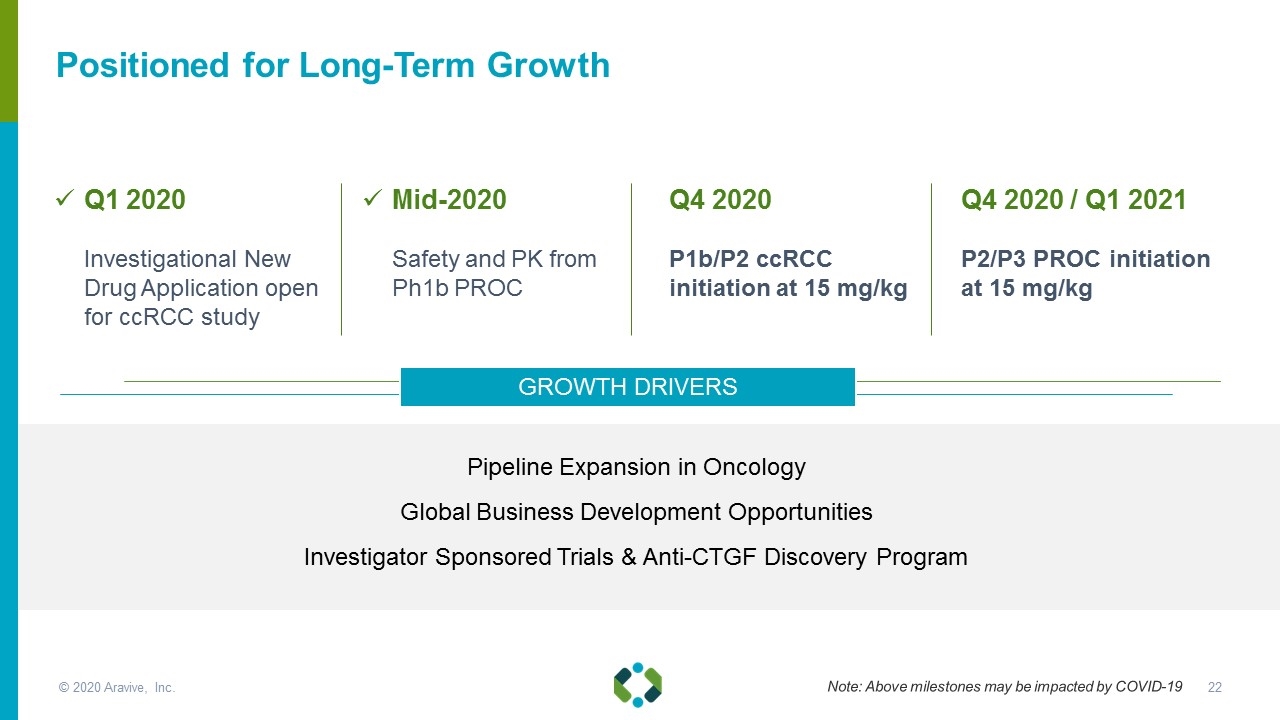
Q1 2020 Investigational New Drug Application open for ccRCC study Note: Above milestones may be impacted by COVID-19 Positioned for Long-Term Growth © 2020 Aravive, Inc. Mid-2020 Safety and PK from Ph1b PROC Q4 2020 P1b/P2 ccRCC initiation at 15 mg/kg Q4 2020 / Q1 2021 P2/P3 PROC initiation at 15 mg/kg GROWTH DRIVERS Pipeline Expansion in Oncology Global Business Development Opportunities Investigator Sponsored Trials & Anti-CTGF Discovery Program
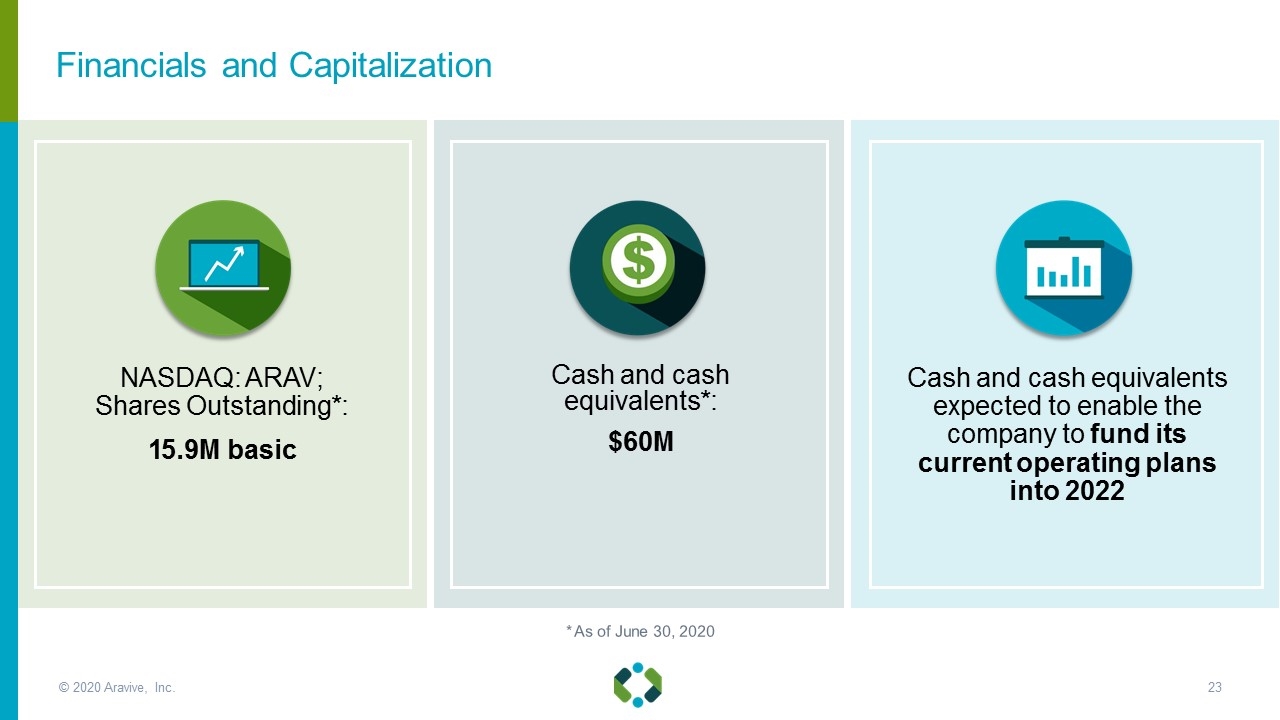
© 2020 Aravive, Inc. NASDAQ: ARAV; Shares Outstanding*: 15.9M basic Cash and cash equivalents*: $60M Cash and cash equivalents expected to enable the company to fund its current operating plans into 2022 * As of June 30, 2020 Financials and Capitalization
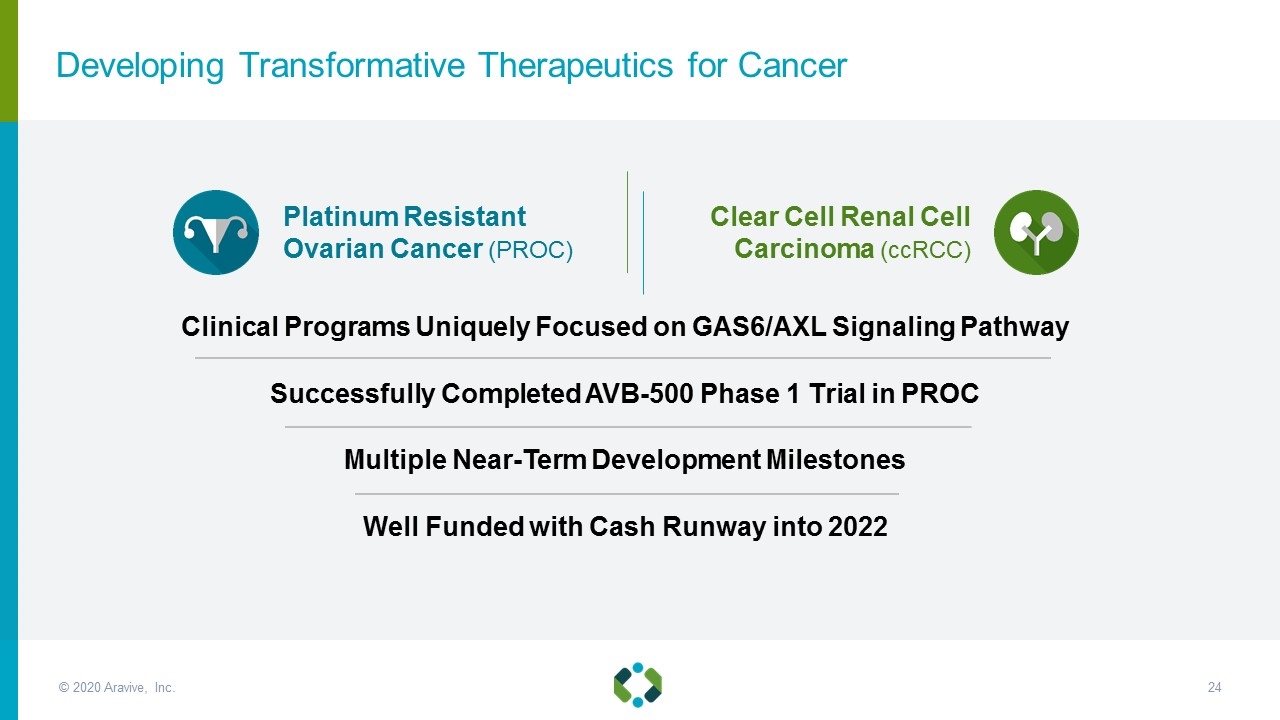
© 2020 Aravive, Inc. Developing Transformative Therapeutics for Cancer Clear Cell Renal Cell Carcinoma (ccRCC) Platinum Resistant Ovarian Cancer (PROC) Clinical Programs Uniquely Focused on GAS6/AXL Signaling Pathway Successfully Completed AVB-500 Phase 1 Trial in PROC Multiple Near-Term Development Milestones Well Funded with Cash Runway into 2022
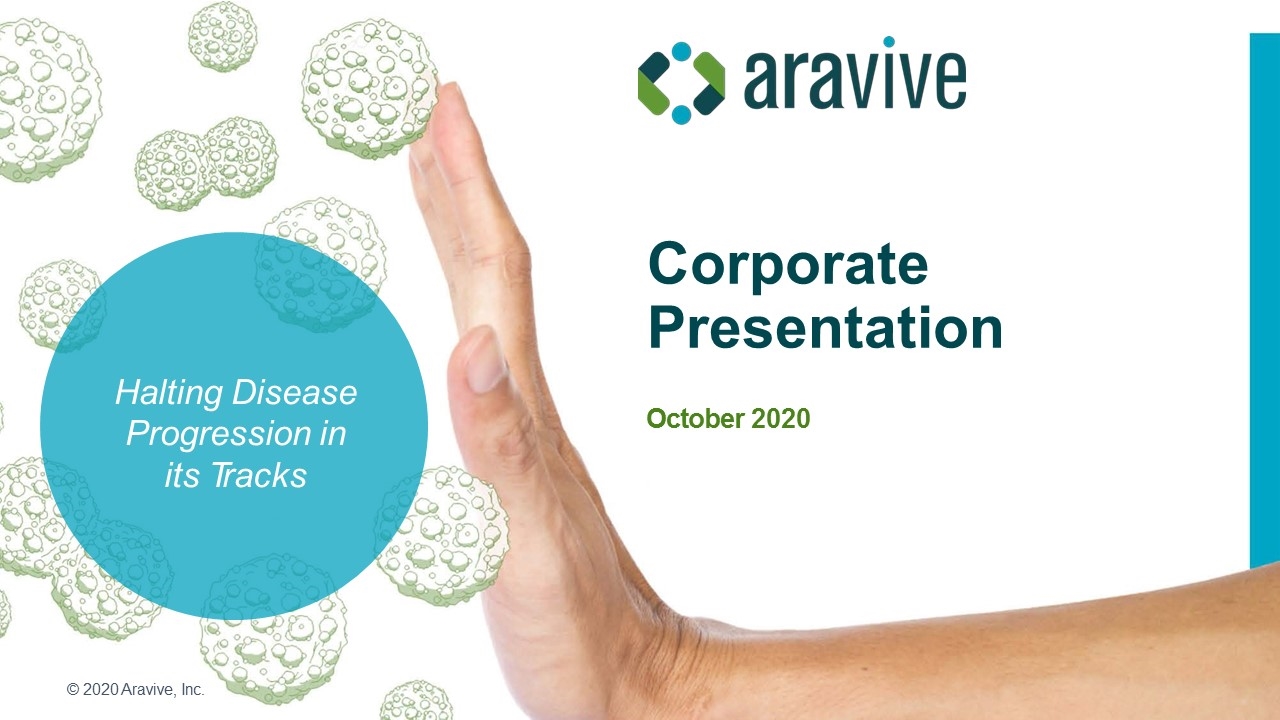
© 2020 Aravive, Inc. Corporate Presentation October 2020 Halting Disease Progression in its Tracks
